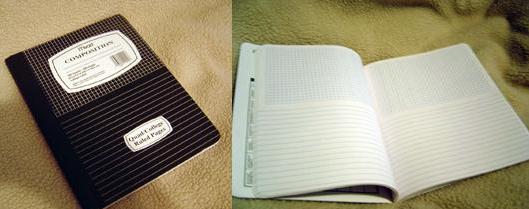Mead® Marble Composition Book, Quadrille and College-Ruled
Printed by MeadWestvaco Corporation
100 Pages, 7 1/2 x 9 3/4, $3.35 list price
Product #09000
An RPG at its best can be a gestalt experience providing the players with an ambulatory mental experience that not only entertains, but also evokes the Aristotelian elements of drama while providing the players a vicarious sense of accomplishment. Players may rejoice as their characters achieve the impossible in a game held together with dice, paper, some simple rules and their limitless imaginations. Tools that can improve the efficiency of the players and the GM can help steer a game toward that pleasant destination, and I recently came across a product so intuitive and amazingly useful to gamers that I marveled that I hadn’t thought of it myself.
Mead now produces a composition book which has the pages split such that the top half of each page is quarter-inch graph paper and the bottom half is college-ruled line paper. The product lists at $3.35, but I found the street price consistently lower. The book is built like the rest of their “marble” composition line: cloth spine, hard cardboard outer cover, soft white paper pages inside with a sewn binding, and blue inking. However, seeing this book’s outer cover with its white and black display transfixed me. I can’t remember a time when I was so enchanted with a product without having even used it. Its gaming applications were immediately obvious to me.
From a GM’s perspective, the Quad/College composition book makes a perfect idea journal. It is small enough to carry tucked inside other notebooks for quick retrieval. The top half of each page is a perfect place to map out mazes, tunnels, cities, or other game locales. The bottom half has plenty of room to write notes, character sketches, or treasure descriptions.
A player would probably find the product equally useful. This is especially true for a designated chronicler or cartographer. While the grid is not large enough to map a large dungeon, it can easily handle subdivisions of such a place and provide ample descriptions to help the players negotiate their way back out again. And, of course, the product is useful for non-fantasy RPGs as well. Star systems, ship designs, military bases and urban neighborhoods can all be handled more efficiently with this clever composition book.
The product isn’t flawless. Mead’s composition books don’t have perforated pages, so removing a page is messy. It would be nice if they offered eighth-inch graph paper as well as the quarter-inch version. The weight of the paper used in the book is light enough that markers can bleed through, messing up the back of the page. Yet this book’s usefulness far outweighs these flaws for players or GMs.
I wish this product had been available when I was doing my most regular gaming as a player, but it wasn’t. Mead only released this product in July of 2004, so it is fairly new. They also released a similar product in 2002 that would be of use to many gamers – a comp book with the top-half of each page blank for illustrations (product #09920). But, it is the graph version that struck me as most universally useful to RPG enthusiasts.
I contacted Mead’s consumer relations department and was told that many times the office supply stores will only stock up on these products during the beginning of the school year, so the products won’t be available for much of the year without special ordering. In fact, Mead doesn’t even carry the product on its own web site. However, I did find that OfficeDepot.com carries it, and it can be looked up by product number on their webpage.
